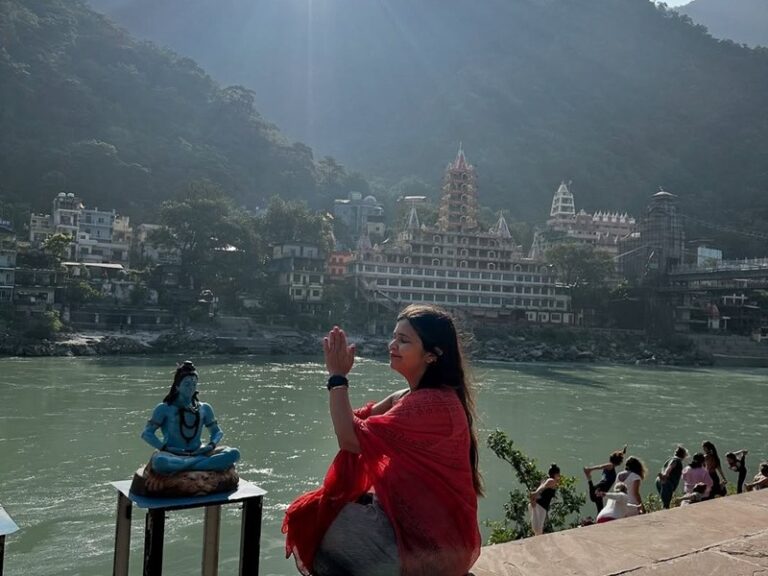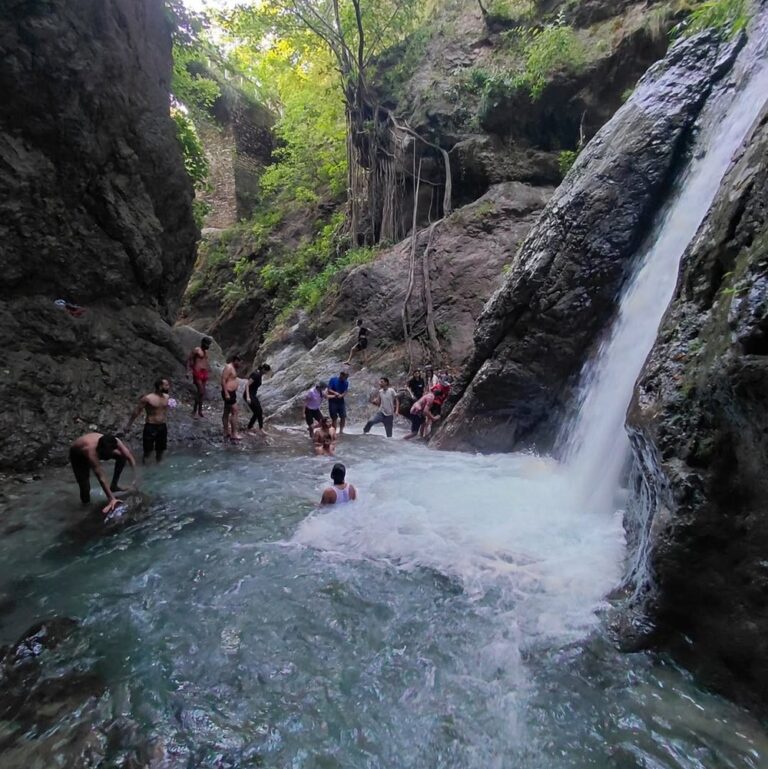5 Mysterious Caves in Rishikesh: Best for Meditative Souls
There are some mysterious caves around Rishikesh that offer tourists and visitors a unique experience. One of the most sought cave in Rishikesh is Vashistha Cave which is just 22 km away from Rishikesh. It is believed that this cave is more than 3,000 years old, where many enlightened beings visited frequently.
Spend Time in the Mysterious Caves
In the region around Rishikesh, there are several mysterious caves that offer tourists a completely new experience. On the Rishikesh–Badrinath route, near Gular, lies the Vashishta Cave, located about 22 kilometers from Rishikesh.
It is believed that this cave is more than 3,000 years old. Even today, many saints and sages can be seen meditating and resting around it. Tradition also holds that this was once the residence of Sage Vashishta, the royal guru of Lord Rama.
Upon entering the cave, one can see a Shivalinga. It is said that in ancient times the cave extended further inside, but due to geological changes, its inner passage is now closed.
On the route connecting to Pavaki Devi, there is also the Loyal Cave, which carries many secrets. Inside, natural stone formations created by calcium and carbon deposits have formed fascinating shapes.
These shapes resemble Lord Ganesha, Lord Shiva, elephants, jellyfish, snakes, and serpents. Similarly, on the trekking path to Neelkanth Temple, there is another cave known as the Jhilmil Cave.
Inside this cave, there is a hollow opening towards the sky, through which sunlight streams into the chamber. The most striking feature is that visiting these caves requires no entry fee.
Among its many wonders, the caves in Rishikesh hold a special place in the hearts of meditation enthusiasts. Many of these caves are tied to ancient legends and offer a serene atmosphere for contemplation and self-discovery.
Overview: Caves in Rishikesh
If you are looking a place where you can escape into nature’s lap nearby the Ganges river, away from the noise of everyday life of Rishikesh, these mythical caves in Rishikesh, are the perfect places to recharge your spirit and soul in the Himalayas of Rishikesh
In this travel blog, I will explore five enchanting caves near Rishikesh that are legendary for their tranquil ambiance and spiritual energy.
Suggested Read- Mahavatar Babaji Cave: The Birthplace of Kriya Yoga
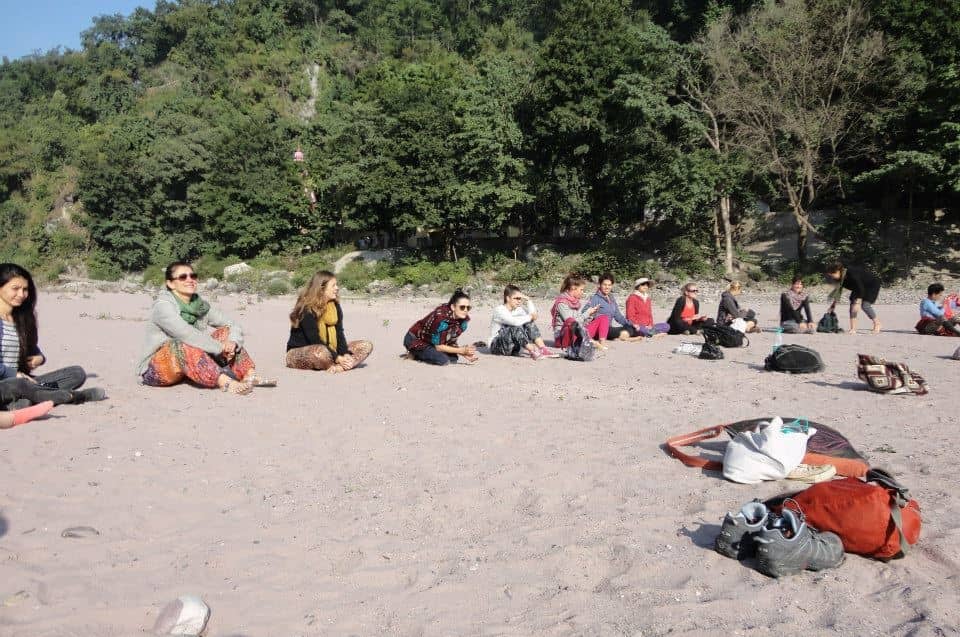
Meditation on the beach at Vasishta Gufa
Vashishta Cave (Vashishta Gufa)
Mythical Background
Vashishta Cave is one of the most famous meditation site near Rishikesh. According to ancient texts, sage Vashishta, one of the Saptarishis (seven great sages), came at this place and meditated here after losing his sons. The cave is a holy aura and has been attracting sadhus, monks, and spiritual seekers for centuries.
How to Reach
Vashishta Cave lies about 22km from Rishikesh, on the Rishikesh-Badrinath road. You can hire a taxi or take a local jeeps privately to reach the village of Gular, then walk down for a short distance towards bank of the Ganges where the cave is located.
What Makes It Special
Inside the cave, the air feels cool and charged with divine energy. The darkness helps you withdraw your senses from out side distractions and take you in a deep in yourself into profound meditation. Just few steps away from the cvae there is Ganga River which flows silently and offering sandy beach to sit and practice yoga which adding extra advantage to this the serene cave in Rishikesh.
“The moment I stepped inside, all worries vanished. I felt connected to something much bigger than myself.”
Meditation Experience
- Very quiet, ideal for both beginner and advanced meditators.
- Morning and evening times are typically less crowded.
- The cave is maintained by a small ashram, so you can stay for longer periods with advance permission.
Suggested Read: Your Best Budget Stay in Rishikesh Tapovan at Om Homestay

Arundhati Cave or Jesus Cave
Mythical Background
This is cave is very close to Vashishta Cave, called as Arundhati Cave also known as Jesus Cave among western tourists . It is the meditation spot , located on the bank of the Ganges river, where Vashishta’s wife, Arundhati visited many times. Local anecdote says that the couple performed deep Tapasya (spiritual austerities) side by side, making this area sacred for couples who seek harmony and spiritual growth together.
How to Reach Jesus Cave
You can find Arundhati Cave on few steps just down to the river bank, take very very short walk from Vashishta Cave or you can ask the ashram staff or locals for directions as it is less known but equally peaceful facing the mountains and the river.
What Makes It Special
Surrounded by Himalayas woods and the soothing sound of the river Ganga, you’ll feel nature’s embrace, setting the mood for gentle introspection and spiritual fulfillment .
Meditation Experience
- Less crowded than Vashishta Cave.
- Perfect for those seeking solitude and silence.
- The spiritual history of the cave inspires a deeper connection to your practice.
Suggestion – Vashistha Cave is the best option for meditation sitting in Rishikesh
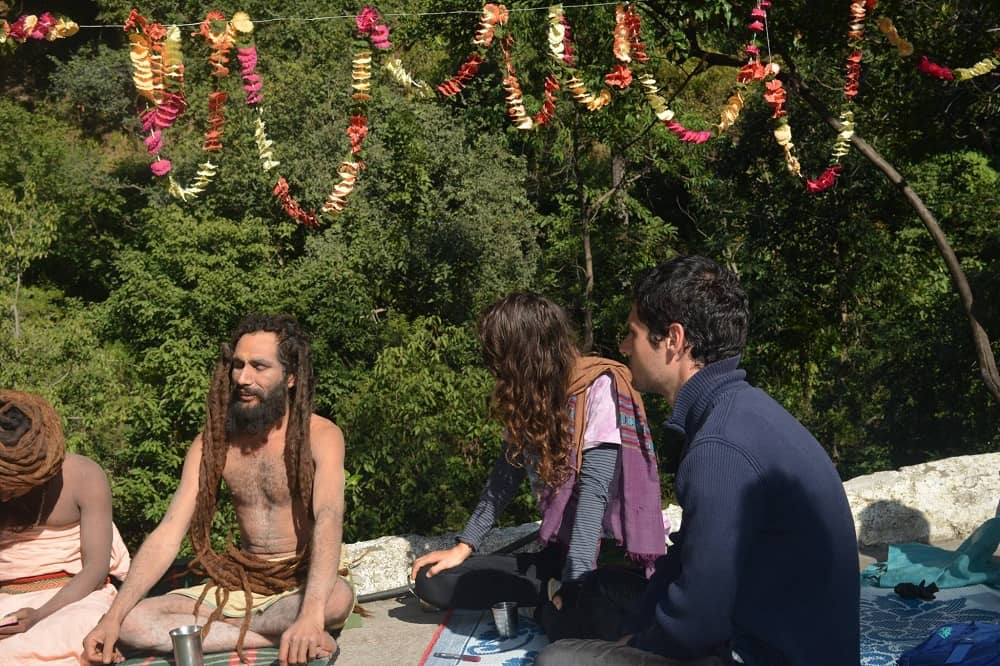
Mauni Baba Cave in Rishikesh: A Living Sanctuary
Rishikesh is now known for its spiritual heritage, breathtaking Himalayan vistas along and fast flowing pristine water of the mother Ganges, it reveals many mystical spots where you some mysterious events still can be felt.
Among them, there is Mauni Baba Cave is a place i9nside the Rajaji National Park behind the Beatles ashram where nature and spirituality mixing the visitor’s experience seamlessly. This unique cave is more than a physical space—it’s a vibrant spiritual retreat for the heart and soul that continues to attract seekers longing for tranquility and spiritual transformation.
The Essence of Mauni Baba Cave
Mauni Baba Cave is a living cave near Ram Jhula suspension Bridge, it has been earned lots of glory so far , yogis , seekers and visitors going to visit for peaceful reflection and meeting with monk who lives there inside the cave. its inner walls radiate an ancient calm and divine energy that many find deeply healing.
Residing beside the cave is a small tented shelter, home to two dedicated Sadhus who keep its traditions alive:
- Jatadhari Baba: The primary Sadhu and spiritual anchor of the cave, he is known for his intense asceticism, he practices a life of austerity, renouncing worldly pleasures and comforts. True to Shaivite traditions (the spiritual path of Lord Shiva).; He is quiet famous as Jatadhari Baba his matted hair is very long long—as it flows down to his feet—a powerful symbol of detachment and devotion.
- Disciple of Mauni Baba: Assisting in daily activities and hospitality, this disciple has devoted his life to Mauni Baba. His presence ensures all visitors and pilgrims to have proper welcoming and guiding them for their comfort and support for their spiritual journey.
The Atmosphere Around
At the Mauni Baba Cave, visitors are welcomed with warmth and respect, regardless of background or experience. The ashram emphasizes:
- Silence and Meditation: The spirit of “mauna” (silence) is revered here, encouraging guests to practice inward contemplation.
- Shaivite Practices: Rituals and meditations are influenced by Shaivism, the tradition dedicated to Lord Shiva, focusing on self-control and surrender.
- Simple Living: Life at the cave is humble. There is basic accommodation, and meals are simple, supporting focus on spiritual pursuits rather than material distractions.
What Makes Mauni Baba Cave Unique?
- Natural Beauty: The cave offers a cool, sheltered environment, surrounded by Rajaji National Park’s forests.
- Spiritual Energy: Years of meditation and prayer by Mauni Baba and countless seekers have made this cave a spiritual powerhouse.
- Living Tradition: The resident’s Sadhus is continuing the legacy, the cave buzzes with spiritual energy and divine life with daily divine routines, and the presence of true asceticism.
Visiting the Cave: Practical Tips
- Respect silence: Maintain a quiet and mindful environment.
- Engage with the Sadhus: If you wish, speak to the resident Sadhus for insights into meditation and Shaivite philosophy.
- Dress modestly: Simple, respectful clothing helps honor the spiritual atmosphere.
- Be prepared for simplicity: Accommodations are basic, focusing on authentic spiritual living.
Suggestion- Top 10 Places to visit in Rishikesh

Jhilmil Cave: A Peaceful Meditation Spot Near Rishikesh
Rishikesh lies on the foothill of the mighty Himalayas. People has been visiting this town for spirituality, yoga, and adventure. But few of them know about a quiet and magical place called Jhilmil Cave. It is about 30 kilometers by road from Rishikesh, located on the mountain that is called Manikoot Parvat, near very famous Shiva Temple, Neelkanth Mahadev Temple.
What Makes Jhilmil Cave Special?
Jhilmil Cave is older than history ancient than mythology and is powerhouse of takeaway energy. The name of the cave derived from a wise spiritual person, his name was Jhilmila Sadhu. He meditated here for many years and became very wise and before leaving this place he decided to leave his whole powerful energy inside the cave. It holds a calm and peaceful atmosphere for visitors now.
History and Legends
The cave is associated with Baba Gorakhnath, a great yogi who was by loved Lord Shiva. He used to perform rituals called Hawan in the cave. Legend says Lord Shiva once spoke to Baba Gorakh Nath here in order to share the secrets of yoga and meditation. The cave is now very important for spiritual seekers and Hindu devotees.
How to Reach Jhilmil Cave
You can reach the cave by 4 km trekking about from Neelkanth Mahadev Temple which is located about 25 km from Rishikesh town. The path is ups and downs through green forests and hills. At some spots it can be rough and slippery, so wear good shoes and take care of yourself. Many prefer going with a guide or in a group, especially if it is their first time.
If you take a trip to the cave from Rishikesh than it takes about half a day. Along the way, you get lovely views of the hills and the Ganges River.
Meditating in Jhilmil Cave
Inside, you find the cool, quiet little dark. It is located such remote place that there is no outside noise and distractions. When you sit in meditation and softly chant “Om,” your voice echoes inside you. Many visitors call this feeling magical and Kundilani energy The silence there helps you relax deeply and connect with yourself through natur.
Tips for Visiting
- Travel in a group or solo but you must ask for a guide.
- Avoid visiting during the rainy season (July–September) because the path can be slippery.
- Start early in the morning to enjoy calm and good weather.
- Carry water, snacks, and a shawl or jacket during winter time
- Bring a meditation mat of you wish to sit inside for comfort inside the cave.
Best Time to Visit
The best months are February to April (spring) and September to November (autumn). These seasons have good weather for trekking and meditation. But it is being visited around the year.
Nearby Attractions
- Neelkanth Mahadev Temple: A famous and holy temple dedicated to Lord Shiva.
- Manikoot Parvat: Offers hiking trails and natural beauty.
- Phool Chatti Ashram: A place for yoga and peaceful retreats near the cave.
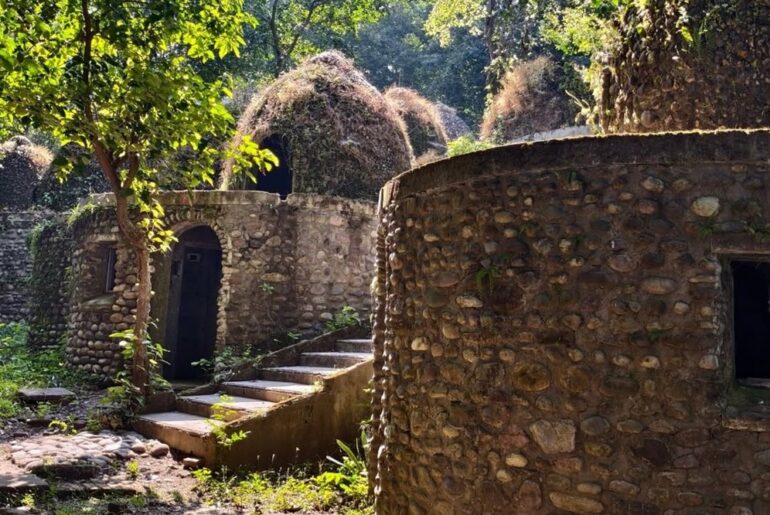
Beatles Ashram Caves (Chaurasi Kutia)
Magical Background of Rishikesh
The Beatles Ashram by the Ganges river , officially, in the Government record, it is known as “Chaurasi Kutia,” is where the legendary Band Beatles visited and composed many of their songs in the year of 1968. The forested area is filled with small caves where Indian yogis practiced intense meditation.
The ashram is now popular among visitors and pilgrims where the legacy of Maharishi Mahesh Yogi is still alive.
How to Reach
The Ashram is located on the eastern bank of River Ganga, inside Rajaji Tiger Reserve, it is about 2 km by walk from the Ram Jhula. You can walk or cycle along down stream of the river Ganga to enter this ashram.
What Makes It Special
The energy here is vibrant and creative. The nature is here on its fullest mode. The walls echo whispers of the Beatles’ experiences, and the numerous small caves around the ashram provide ample nooks for meditation.
Meditation Experience
- The ashram’s peaceful ambiance brings clarity to the mind.
- Artistic graffiti, tranquil gardens, and the ruins add to the mystical feel.
- Choose a quiet cave among the many Kutias (meditation cells) to sit in silence.
Happy travels! Enjoy the scenic beauty and the tranquility of the caves along the way!
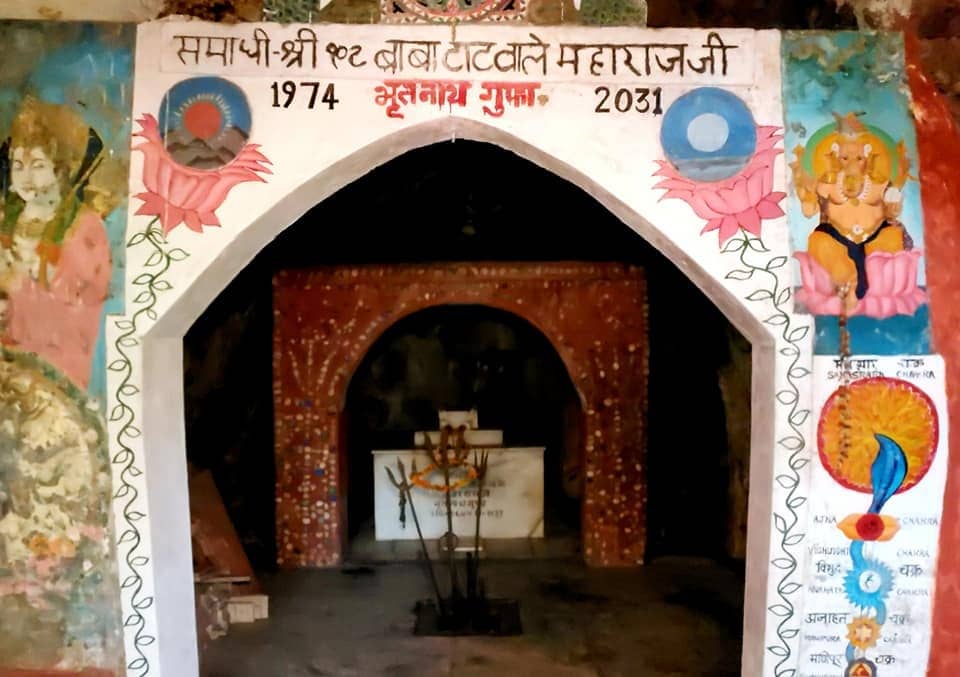
Tat Wale Baba Cave in Rishikesh
Tat Wale Baba Cave is a peaceful and powerful place. It sits above Rishikesh, behind the Bootnath Temple. It is very powerful place but not for tourists only for seeker and devotees. Sometime, they not allowed to visitors because they come to take photo and to chat. Whereas this place for silent retreat and introspection.
About Tat Wale Baba
Sri Tat Wale Baba is not very famous like today gurus but as one of the great saints of Rishikesh. He lived inside the cave which is inside the dense jungle and it seems to me very hard to live there, but now , little easy to stay there but not for long.
Many followers, or yogis, traveled from different parts of India and even from other countries to meet him and learn from his wisdom. Even Maharishi Mahesh Yogi, the teacher who guided The Beatles in meditation, called Sri Tat Wale Baba his guru.
Tat Wale Baba was very tall, almost two meters, and extremely strong. He could lift heavy stones with ease, but his voice was gentle and soft, like a child’s.
His Lifestyle
Tat Wale Baba lived very simple life. He wore only a thin piece of jute fabric, no matter what the season. When it rained or turned cold, he sometimes used a jute sackcloth for protection. This is how he earned the name Tat Wale, which means “one who wears sackcloth of jute.”
He looked much younger than his real age. Some people believed he was nearly 100 years old, even though his face seemed to belong to a man in his 30s. Pilgrims and visitors said they felt healed just by sitting near him or spending time in his presence.
Tat Wale Baba and his followers focused on finding the truth through yoga and meditation. Together, they improved the hillside around the cave. They created terraces, made spots for bathing, and changed the caves into comfortable places for meditating and living.
Early Life of Tat Wale Baba
Tat Wale Baba was born into a spiritual family of middle-class farmers in Punjab, India. He did not study much in school because he was busy helping his parents on the farm.
From the age of eight or nine, he was naturally drawn to meditation. He meditated as much as he could, even as a boy. When he became a teenager, he grew strong and fit. His friends told him to join the army, and he tried for two months. But he did not enjoy military life, so he decided to become a sadhu, a holy man.
Tat Wale Baba traveled in search of a teacher. He met Sri Jagannath Dasji in Ayodhya, who gave him the name Sri Mahavir Dash Ji. Later, when he started wearing jute sackcloth, people began to call him Tat Wale, and the name stayed with him all his life.
His Legacy
Tat Wale Baba’s life story inspires many people to begin their own search for spiritual truth. His simple way of living, deep meditation practice, and kindness continue to touch the lives of seekers from all over t
Why Meditate in a Cave?
practice meditation there at the cave, is completely different from practicing in your home or at a yoga studio. The vibrant energy, and quiet environment helps block out distractions. The ancient vibrations there invite you to drop daily worries and explore deeper states of awareness. Many practitioners report a stronger connection to the self and the feeling of timelessness that enhances their meditation.
The Best Time to Visit
Spring (February to April) and autumn (September to November) offer the best weather. Avoid the rainy season when rain water make it inaccessible. Early mornings and late afternoons are ideal for meditation.
How to Prepare for a Meditative Cave Retreat
- Start with short meditation sessions, increasing your time gradually.
- Learn basic breathing techniques to achieve calmness quickly.
- Read about the history of each cave before visiting for better context.
- Traveling in a group can be more fun and safe for remote areas.
Nearby Attractions for Spiritual Travelers
- Triveni Ghat: Witness the Ganga Aarti, a soulful evening ritual by the river.
- Lakshman Jhula and Ram Jhula: Iconic hanging bridges.
- Parmarth Niketan Ashram: Attend yoga classes and guided meditations.
- Neelkanth Mahadev Temple: Located near Manikut Cave, it is an important Hindu shrine.
Conclusion: Experience Rishikesh’s Mystical Charm
These caves are not visiting space but they are witnessing silent for centuries of monks and spiritual masters. You can experience deep meditation, mystical experiences, or spiritual breakthroughs. Mediating inside any of these caves, you will sense peace that lingers in the air, inviting you to journey within.
Whether you’re a seasoned meditator or a curious traveler, these 5 caves provide a magical blend spiritual experience and meditative silence. With a little planning, you can not only visit these sacred sites but also carry home a heart that feels lighter and a mind that sees clearer.
So pack your bags and get ready to lose yourself—and find yourself—in the magical caves of Rishikesh.
Caves in Rishikesh Caves in Rishikesh Caves in Rishikesh Caves in Rishikesh Caves in Rishikesh Caves in Rishikesh Caves in Rishikesh Caves in Rishikesh Caves in Rishikesh Caves in Rishikesh
Caves in Rishikesh Caves in Rishikesh Caves in Rishikesh Caves in Rishikesh Caves in Rishikesh Caves in Rishikesh Caves in Rishikesh Caves in Rishikesh Caves in Rishikesh Caves in Rishikesh Caves in Rishikesh Caves in Rishikesh Caves in Rishikesh Caves in Rishikesh Caves in Rishikesh Caves in Rishikesh Caves in Rishikesh Caves in Rishikesh









